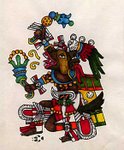
----------El caballero de la cara triste
------------------¡Y Dios no te dé paz y sí gloria!
-------------------------------------------- Miguel de Unamuno
Tratándose del canto
-----en un llano de arbustos silvestres
infestado de las ramillas girantes
----------de molinos rompe cielos,
una figura consintiendo la edad
-----y una mente cavernosa
alanzó al sol embarrando su lanza de luz.
-----(y una estrella mugrosa
----------encendió un cigarrillo lucero
-----para guiar a un guerrero
----------a su lavadura.)
-----Si sucediera una estrella,
-----naciera un canto
-----en algún año decisivo
prometiendo pan y pescados
de que uno no fuera seguro se multiplicaran
¿pagaría la gloria incierta de una aguda herida
el precio de derramar la paz
en una red de empeño enmarañada?
El alto atrever camina en patas flacas
y demasiadas veces la causa de muerte
--------son las estrellas.
----------© Rafael Jesús González 2009
by Honoré Daumier
----------The Knight of the Sad Face
-----------------¡Y Dios no te dé paz y sí gloria!
-------------------------------------------Miguel de Unamuno
Treating of songs
----------in a wild wood plain
infested with twirling sprigs
---------of sky-tearing mills,
a figure indulging age & a cavern mind
speared the sun smearing his lance with light.
-----(& a soiled star lit a cigarette star
-----to guide a warrior to his washing)
-----If a star were to happen,
-----a song born
-----to some decisive year
promising bread & fishes
one was not sure would multiply,
would the uncertain glory of an acute wound
pay the price of spilling peace
-----into a fouled net of undertaking?
High daring walks on spindly legs
& stars too often are the cause of death.
---------------© Rafael Jesús González 2009
(in Mark in Time; Nick Harvey, Ed., Glide Publications,
San Francisco 1971; author’s copyrights.)

-
-----------------¡Y Dios no te dé paz y sí gloria!
-------------------------------------------Miguel de Unamuno
Treating of songs
----------in a wild wood plain
infested with twirling sprigs
---------of sky-tearing mills,
a figure indulging age & a cavern mind
speared the sun smearing his lance with light.
-----(& a soiled star lit a cigarette star
-----to guide a warrior to his washing)
-----If a star were to happen,
-----a song born
-----to some decisive year
promising bread & fishes
one was not sure would multiply,
would the uncertain glory of an acute wound
pay the price of spilling peace
-----into a fouled net of undertaking?
High daring walks on spindly legs
& stars too often are the cause of death.
---------------© Rafael Jesús González 2009
(in Mark in Time; Nick Harvey, Ed., Glide Publications,
San Francisco 1971; author’s copyrights.)

-











